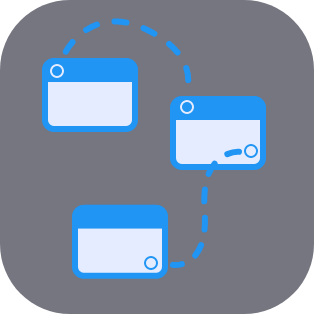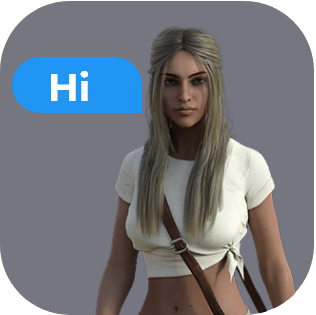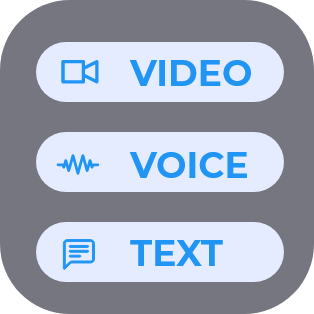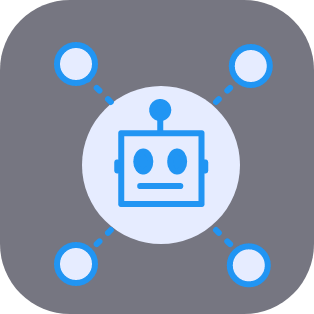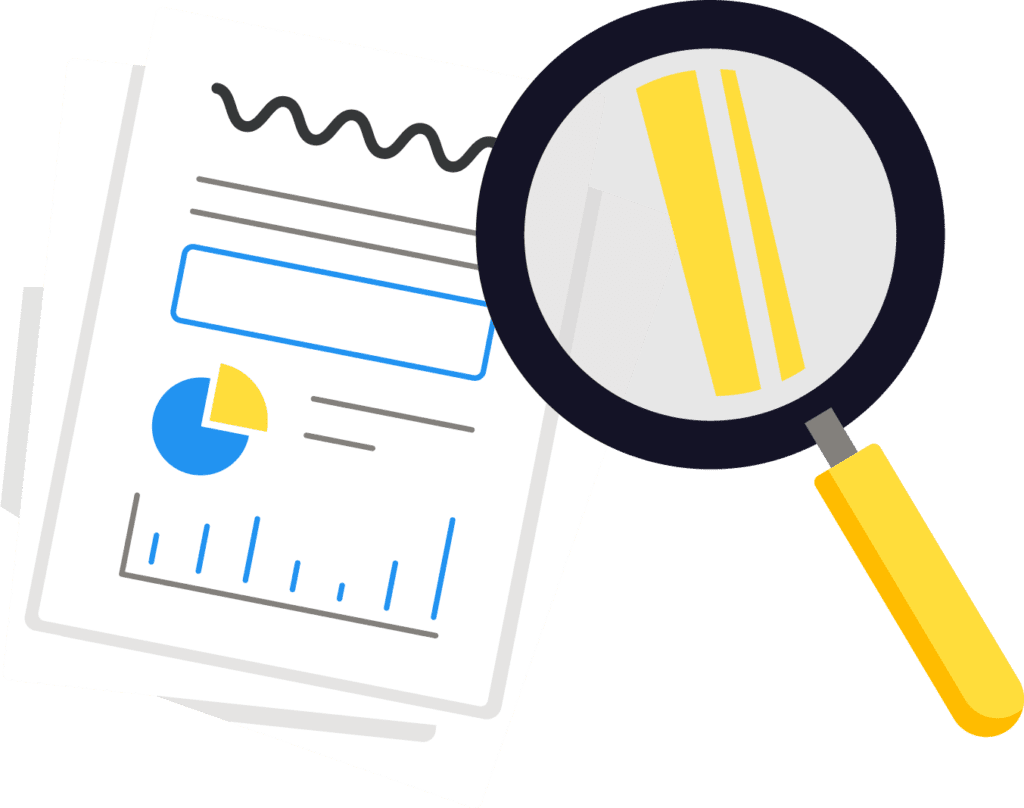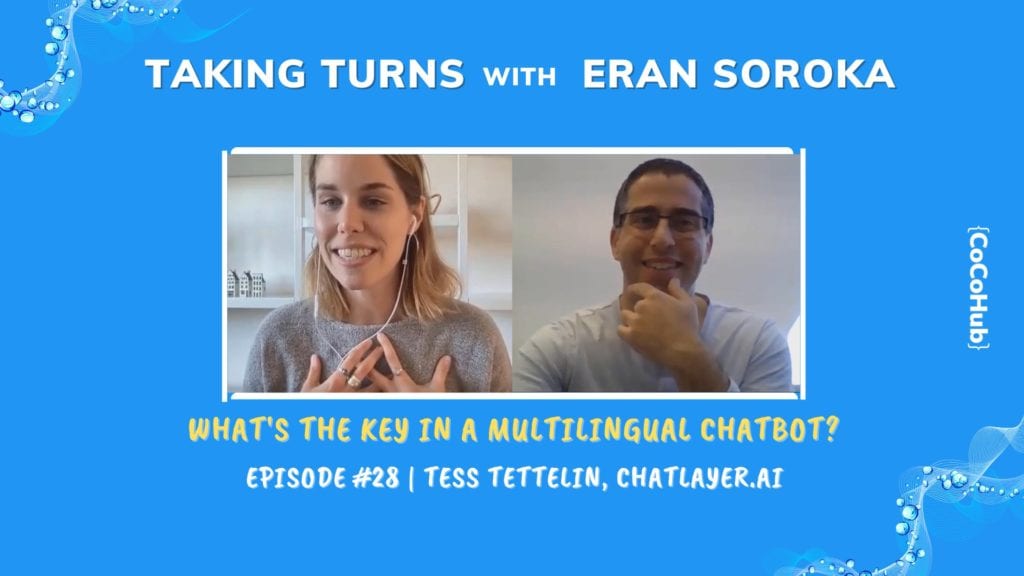In a global society, where several countries have more than one official language and most of us know more than one language, creating a multilingual chatbot can be a huge challenge.
A Multilingual chatbot needs to take into account the user’s expectations, and adapt itself – in the conversation’s beginning, and sometimes even during it. So, what’s the best way to approach it?
In order to find out, we reached out to Tess Tettelin. During her work as a conversational designer for Chatlayer.ai, she tackles that challenge as well. Since Belgium has 3 official languages – Dutch, French and German – this is a real issue for her. Aside from that, Tess also talked to us about how her previous experience as a UX copywriter and social media editor to become a better conversation designer. These insights, and so much more, awaits in the 28th episode of Taking Turns with Eran Soroka.
How did you get to conversation design?
I wish I could say that I’ve always been interested in AI and chatbots and everything. However, this stuff wasn’t really a thing when I had to pick a degree. So, I kind of rolled into it by accident. Nevertheless, I do think that all of my previous experience has prepared me really well for being a conversation designer.
Actually, I’ve always been interested in people, the way we express ourselves. Why do we do what we do? What words do we use to convey what we think, what we feel? So I first tried my hand at psychology, but the math overwhelmed me so I gave that up after a year. Then I did a bit of digital design. First I worked in social media, and as a UX copywriter at Zalando in Berlin. Later, when my partner got a job offer in Belgium, we relocated.
Then I was approached by Chatlayer to come work for them as a conversation designer. Following that, I started researching what a conversation designer is. I just totally fell in love with the role, and I’m still very happy that I accepted.
What is the project or chatbot that you’re most proud of?
It has to be the unreadmessages.org project, which I worked on for Sinch. Sinch launched the first ever chat documentary, called Unread Messages. Through that, people could explore real text conversations between real people about sensitive issues in today’s culture. Especially nowadays, when complex cultural issues can divide nations, I find it very valuable. Ultimately, for me, the only way to move forward is to hear each other out and to have conversations. Though they might be difficult – when they’re honest and when you have a good heart, they have to be had.
So my job was to build a chatbot that helps people navigate these stories. Additionally, it gives more information about the campaign and about the NGO that it is supporting. Initially I found it quite scary to build a bot to handle topics like race, feminism and gender equality. However, it’s so good that a big company like Sinch is offering a platform to these people and to their stories. Because there are stories that most of us probably wouldn’t hear about and definitely not in this much detail.
So, yes, I’m very proud of working on that campaign. Especially because of the polarization that’s happening. Nowadays we’re all moving away from each other when we should be moving closer.
Previously on Taking Turns | To the full playlist
Janaina Pereira knows how to build a banking chatbot
Jeanna Isham brings the right sound to your conversational experience
David Devoto already knows what his customers want from a chatbot
What’s the one thing every good bot or voice assistant must have, in your opinion?
I think the most important thing when you’re building a chatbot is scoping. Often I see clients getting carried away with the technology, wanting their bot to do everything. Simply, that’s not possible. Although the tech is really good, but it still has its limitations.
So that’s why I spend a lot of time on scoping and picking the right use cases. And that’s what makes a successful bot. What do you want this bot to do for your users, what don’t you want it to do or what can’t it do just yet? So I think it’s better to start with a handful of use cases, do them really, really well. After spending a lot of time on perfectioning those, add more use cases on top.
Tied to that, is understanding your user, knowing the user who you’re building this bot for. Then, what are they expect of the bots, not only in terms of tasks that the bot can do, but also personality. Because I see a lot of bots that are functional, they get the task done, but they’re not fun. Ultimately, if a bot helps the user and also manages to make that experience really joyful, surprising or delightful, you have a really good bot that people will reuse as well.
What best practices are you bringing from your experience in UX and Social Media to conversation design?
Having worked as a copywriter, first on longer content pieces and then later the UX copywriter, I’ve spent a lot of time thinking about how specific words can convey or trigger specific feelings, how the words make people feel. As previously mentioned, I was always fascinated by the way people express themselves and what gestures and words we use to communicate.
Then, in UX, the trick is to communicate a lot in as little characters as possible. So you have to be concise and short. After all, our screens are getting smaller and our attention span is getting shorter. So you need to communicate a lot as little as possible. So that helped me a lot with bot building. In addition,
social media has helped me understand channels – their possibilities, restrictions, how users use them. Also, there was user research: There’s no such thing as a universal user. Since you’re always working with different groups of users, you have to know – what do they like? What are they expecting? What does each group need? So I always put the user first in my bot building.
In Belgium there’s more than one main official language. How do you handle the multilingual chatbot challenge?
So, detecting the user’s language isn’t that much of a problem. At Chatlayer, we built our own NLP, and it’s quite advanced. So we’re really good at understanding the user and detecting the language that they’re speaking. Since we support over 100 languages, we’re really proud of it – it’s very inclusive and easy to use.
However, written language or spoken language is so much more than just the standard words. For example, shorthand abbreviations, emojis, cultural considerations – these all are different, depending on the users’ region. So understanding that, and responding correctly to that language that requires some expertise in some regional knowledge. That’s always a bit of a challenge or the difficult part of the multilingual chatbot.
Also, people can mix language which can confuse the bot & can confuse the language recognition. For instance, in Africa, people may mix English and Swahili in Kenya or French and Arabic in Algeria. So I usually solve or avoid confusion by just asking the user in what language they want to continue. In my opinion, that’s the best way to solve it.
What’s the funniest or most awkward thing that happened to you as a conversation designer?
One thing that comes straight to mind. During building one of my first bots – during my first week – I had to build a bot on Facebook messenger. It was like a FAQ bot, I think. While testing it, all of the sudden, it was saying things that I didn’t write or include. “Hi Tess, I know who you are”. Or, “We’re gonna take over the world, me and my bot friends”. And I was like, What is happening? What is happening?
So I messaged my manager, ‘the strangest thing is happening to me. I feel like I’m going crazy’? Then it turned out that he also had access to the Facebook page where the bot was living. So he could just write messages back to me, which I didn’t know then that was possible. So those were very confusing 10 minutes of my life…
What tips or advice you can have for people that want to move into conversation design?
For me, the best way to start is by just doing. Actually, that’s how I learn as well. So what I would advise people who are interested in conversation design, conversational AI? First, read a couple of articles, watch a couple of interviews like this one here, learn what are we doing. Then if that seems like something you would enjoy, start building your skills. Sign up to a bot building platform, get a free account. Out there, there’s a lot of platforms out there that offer trial accounts. Then, start building a bot.
For example, give yourself a fictional brief – like a bot that can place online orders – and just start building that. Then I think you’re going to encounter things that you need to solve, and to Google a bit more. After that, you’re going to train yourself, that’s the best way to do it. Once your bot is done, don’t be afraid to reach out to someone from within the conversation design community. Ask them to review the bot and just give you some pointers and tips. I’m always very happy to do that.
Tell us a bit about Chatlayer.ai, and about your role there.
So, Chatlayer is a very fun company based in beautiful Antwerp, Belgium. Basically we offer an easy to use, no coding bot-building platform where literally anyone can build AI-powered Voice and Chat bots. Our clients come from all industries, they’re not just developers or expert bot builders. Also, we see a lot of business people just building bots on the platform because it is so easy to use. Since they’re the ones who know their customers best – to us, it makes total sense that they’re also the ones building the bot.
In 2020, we became a product within Sinch, a global leader in personalized mobile engagement. Then, the cool thing about being part of Sinch is that we can offer a lot of channels and integrate very easily with the Sinch portfolio. They have a huge global network. So with just a few clicks, our clients can connect bots to multiple channels like Facebook Messenger, WhatsApp, SMS. And you can also build a multilingual chatbot. So you build in one language, and in few clicks, you can activate it in any language that you want. It’s a great way to create a multilingual chatbot, and it’s really good to have that support in that network as well.
As a conversation designer, I help the product team build an amazing platform that suits our customers’ wants and needs. Also I review client-built bots, and I often teach workshops and trainings. Besides that, I build bots for bigger, more commercial campaigns like the one unread messages.org. Then, I also consult on bot building whenever needed. Finally, I get to do fun interviews like this one.
More Compelling CoContent
How to give your chatbot a face on Zoom?
How to invite a chatbot to Google Meet?
What is Wizard of Oz testing? And an intent? Check out our glossary
Now for the Lorena Restrepo honorary question – Give us one forecast for the future of Conversational AI.
Eventually, we’ll see an increasing expansion of conversational AI from voice and text to rich media and multimodal interactions. Hence, conversational assistants cannot just hear but can also see and maybe give information to the user, by combining visual media with voice and text. Later, in the long term, the boundary between a phone call and a digital interaction will blur. Thus, customers can interact with the brand the way they want to – phone, Whatsapp, etc. It’d be a channel-less, connected journey throughout one session, across multiple channels.
Also, robots will become more and more human-like. An interesting woman to watch in this space is Cynthia Breazeal. She’s a pioneer of social robotics and human-robot interaction, and she made a robot called Jibo, a household robot companion. Nowadays, they’re investigating whether robots like Jibo can actually help improve mental health and well-being by just providing companionship.
Actually that can be the future of AI – just finding ways to use robots and virtual programs to help support us people.
Next time, another episode of Coming To Terms with Miri is coming your way! Hungry for more? Join our newsletter | Follow us on YouTube | LinkedIn | Twitter | Instagram | Or join our communities on Discord & Meetup

